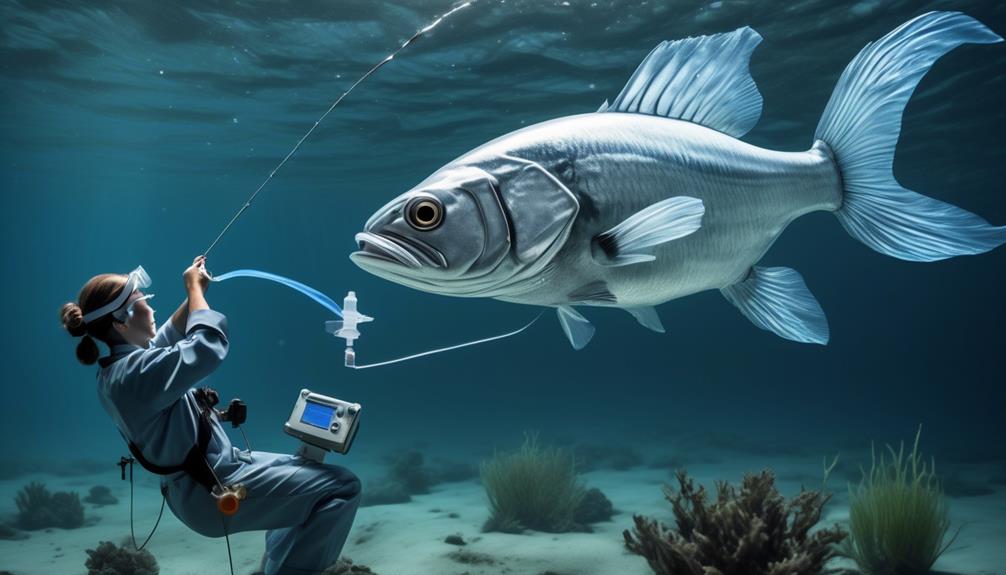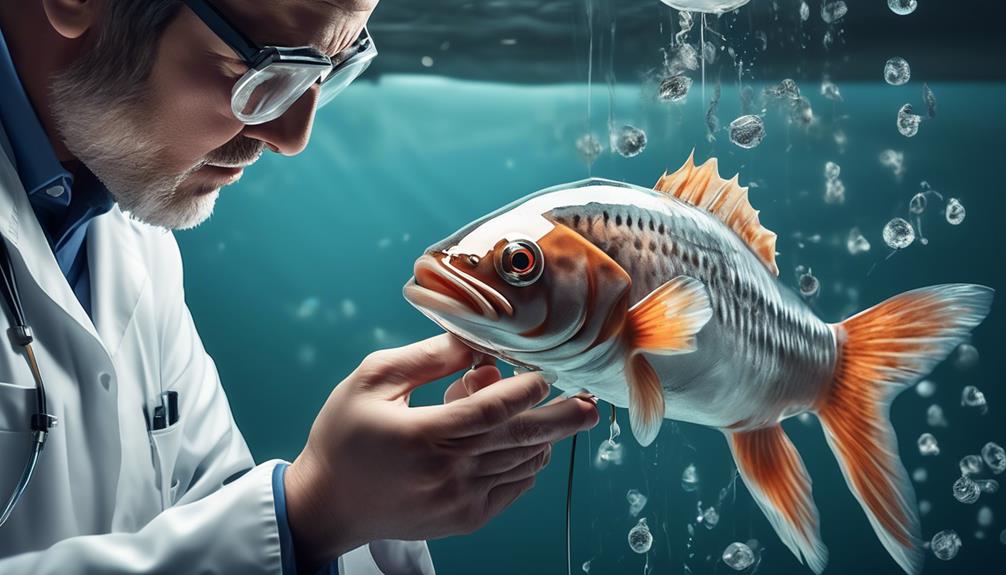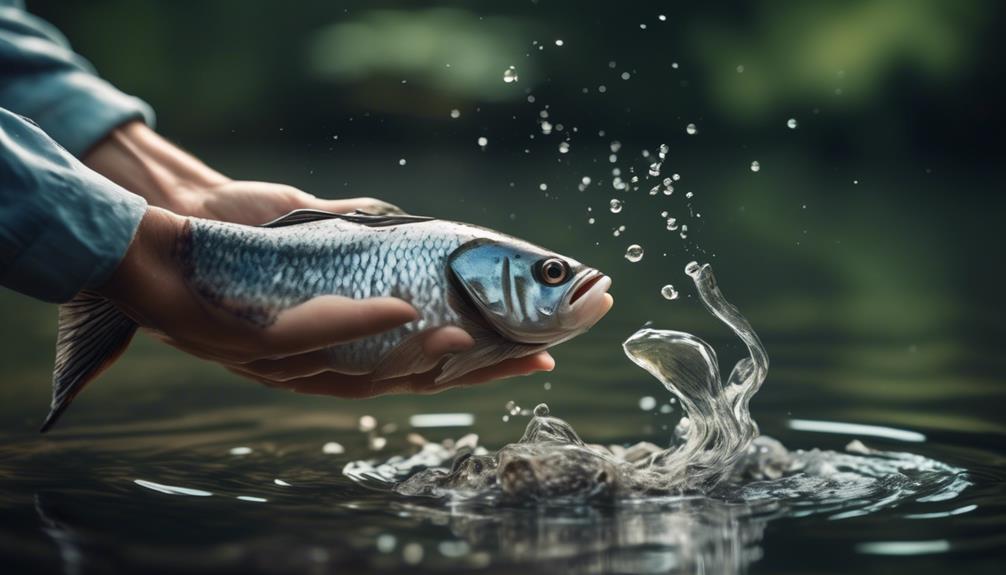You may have heard that catch and release is a conservation practice, but have you ever wondered about the scientific evidence behind it?
Research has uncovered surprising findings about the effects of catch and release on fish health and survival. From the impact of hook type on fish mortality to the long-term effects on reproductive success, the studies on catch and release have provided valuable insights.
But what do these studies reveal about the best practices for catch and release?
Effect of Hook Type on Fish Survival
The type of hook used during catch and release fishing directly impacts the survival rate of the fish. Hook design plays a crucial role in determining fish mortality after release. Studies have shown that certain hook types are more effective in minimizing harm to the fish, thus increasing their chances of survival after being caught and released.
Research has indicated that circle hooks are particularly effective in reducing fish mortality compared to traditional J-hooks. The unique design of circle hooks, with their circular shape and inward-pointing hook, often results in fewer deep hooking incidents. This means that the fish is less likely to suffer internal injuries, making it more likely to survive after being released back into the water.
Additionally, barbless hooks, which are designed to make it easier to remove the hook from the fish's mouth, have also been shown to contribute to higher survival rates among released fish.
Furthermore, advancements in hook design, such as using materials that dissolve over time, have shown promise in further reducing the impact on fish survival. By using biodegradable hooks, the risk of long-term harm to the fish is minimized, ultimately contributing to the preservation of fish populations.
Stress Response in Caught Fish
Experiencing the stress of being caught can have a significant impact on the health and survival of fish in catch and release scenarios. When fish are hooked and subsequently released, they experience a surge in cortisol levels, a hormone released in response to stress. This physiological impact can have serious consequences for the fish.
Research has shown that the increased cortisol levels in fish due to the stress of being caught can lead to a range of negative effects on their health. Elevated cortisol levels can suppress the immune system, making fish more susceptible to diseases and infections. Furthermore, prolonged exposure to heightened cortisol levels can impair the fish's growth and reproductive capabilities, affecting their long-term survival and population sustainability.
In addition, the stress response in caught fish can result in behavioral changes that may further threaten their survival. For example, fish may exhibit reduced feeding behavior or altered movement patterns after being released, which can impact their ability to forage for food and avoid predators.
Understanding the stress response in caught fish is crucial for implementing catch and release practices that minimize harm to fish populations. By considering the physiological impact of stress on fish, anglers and researchers can work together to develop strategies that prioritize the well-being and conservation of fish during catch and release activities.
Fish Behavior Post-Release
After being released, fish may exhibit changes in behavior that impact their ability to thrive in their natural habitat. Understanding these changes is crucial for ensuring the successful catch and release of fish. Here are some key behavioral changes observed in fish post-release:
- Predation Risk: When fish are caught and released, they may become more susceptible to predation. The stress and exhaustion from being caught can impair their ability to evade predators, making them easy targets. This increased vulnerability can have significant implications for the survival of released fish in the wild.
- Habitat Selection: Catch and release can also affect the habitat selection of fish. Some studies have shown that released fish may exhibit altered preferences for habitat, potentially avoiding areas where they were previously caught. This altered habitat selection can disrupt their natural behaviors and impact their ability to find suitable food and shelter.
- Feeding Behavior: Post-release, some fish may experience changes in their feeding behavior. They might become less active in foraging for food, leading to reduced energy intake and potential impacts on their growth and overall health.
- Social Interactions: The stress of being caught and released can also influence the social dynamics of fish populations. Released individuals may experience changes in their interactions with other fish, affecting their social structure and potentially leading to long-term behavioral changes within the population.
Understanding these post-release behavioral changes is critical for implementing effective catch and release practices that minimize the negative impacts on fish populations.
Impact of Handling Time on Fish Health
As you consider the impact of handling time on fish health, it's crucial to recognize how the duration of handling during catch and release can significantly influence the post-release behavior and well-being of the fish. Handling techniques play a pivotal role in determining fish mortality and human impact on fish survival.
Research has shown that the longer the handling time, the greater the potential for negative effects on the fish's health and survival. Proper handling techniques, such as minimizing air exposure, using wet hands or gloves, and employing non-invasive tools for hook removal, can help reduce the impact of handling time on fish health.
When fish are subjected to prolonged handling, they experience increased stress, which can lead to physiological disturbances and decreased survival rates post-release. Additionally, extended handling time can result in physical injuries, such as damage to the fish's protective mucus layer, making them more susceptible to infections and predators.
Understanding the implications of handling time on fish health is essential for promoting responsible catch and release practices. By minimizing the duration of handling and employing gentle and efficient techniques, anglers can contribute to the overall well-being and survival of released fish.
Ultimately, the goal is to ensure that fish have the best chance of recovering from the stress of capture and release, thereby maintaining healthy populations for future generations of anglers to enjoy.
Survival Rates of Released Fish
How can handling techniques impact the survival rates of released fish? The way you handle and release a fish can significantly influence its chances of survival. Here are a few key factors to consider:
- Minimize air exposure: When you bring a fish to the surface, it experiences a sudden change in pressure, which can cause barotrauma. Limiting the time a fish spends out of the water can help reduce the risk of barotrauma and increase its chances of survival.
- Use proper handling techniques: Avoid touching the fish with dry hands or rough surfaces as this can damage their delicate protective mucus layer, leaving them vulnerable to infections. Using wet hands or a soft, knotless mesh net can help minimize harm to the fish.
- Avoid deep hooking: If a fish is deeply hooked, it can cause significant damage to vital organs. Using barbless hooks, proper hook removal tools, and techniques can help reduce the likelihood of deep hooking and increase the fish's chances of survival upon release.
- Minimize fight time: Prolonged fights can exhaust fish, making them more susceptible to predators and less likely to survive post-release. Using appropriate tackle and gear for the targeted species can help reduce fight times and improve the fish's chances of survival.
Understanding and implementing these handling techniques can play a crucial role in minimizing release mortality and ensuring the survival of fish after being caught and released.
Influence of Water Temperature on Fish Recovery
Understanding the impact of water temperature on fish recovery is essential for improving the success of catch and release practices. Fish have specific temperature tolerances, and when water temperatures exceed or fall below these limits, it can significantly affect their ability to recover after being released.
Warmer water holds less dissolved oxygen, which is crucial for fish respiration. When fish are caught and then released in warm water, their already stressed systems can struggle due to reduced oxygen levels, leading to increased mortality rates. Conversely, in colder water, a fish's metabolism slows down, and they may struggle to recover due to decreased activity and feeding.
Research has shown that fish species have varying temperature tolerances. For example, trout are known to have a narrow temperature range for optimal recovery. When water temperatures exceed this range, their recovery rates decline. Similarly, warm-water species such as bass have different temperature tolerances, but they also face challenges in warm, low-oxygen water.
To improve fish recovery after catch and release, it's crucial for anglers to be aware of the water temperature and its potential impact on the species they're targeting. To mitigate the impact of water temperature on fish recovery, releasing fish in areas with suitable temperatures and higher oxygen levels can increase their chances of survival. Additionally, using proper handling techniques and minimizing air exposure can further aid in the successful recovery of released fish.
Barotrauma in Deepwater Release

When releasing fish caught from deep water, carefully managing barotrauma can significantly impact their chances of survival. Preventing barotrauma is critical for deepwater release to ensure fish health and minimize fish mortality. Here are some key considerations for effective barotrauma management and deepwater release techniques:
- Release Depth: When releasing fish from deep water, it's essential to consider the depth at which the fish were caught. Fish brought up from significant depths can experience barotrauma due to the rapid change in pressure. Releasing them at the same depth or using descending devices can help mitigate the effects of barotrauma.
- Proper Venting: Utilizing proper venting techniques can aid in the release of built-up gases in fish suffering from barotrauma. This can involve inserting a venting tool at a specific location to allow the gases to escape, increasing the likelihood of survival upon release.
- Use of Descending Devices: Descending devices, such as weighted hooks or inverted hooks, can be valuable tools for releasing fish back to their original depth. These devices assist in returning the fish to deeper waters, aiding in their recovery from barotrauma.
- Fish Conservation: Implementing effective barotrauma management techniques is crucial for fish conservation efforts. By ensuring that released fish have a higher chance of survival, anglers can contribute to the sustainability of fish populations.
Long-Term Effects on Reproductive Success
Effective management of barotrauma in deepwater release can have significant implications for the long-term reproductive success of released fish. Barotrauma, caused by rapid changes in pressure when fish are brought to the surface, can affect their ability to reproduce after release. Research has shown that fish affected by barotrauma may experience reduced reproductive success due to the stress and physical damage caused by the rapid pressure changes. This can impact the overall population dynamics of fish species subjected to catch and release practices.
Reproductive behavior in fish can be influenced by their physical condition, and barotrauma can hinder their ability to engage in normal reproductive activities. For example, fish with barotrauma may struggle to reach their spawning grounds or compete for mates, ultimately leading to decreased reproductive success. Furthermore, the stress of capture and release can disrupt hormone levels and mating behaviors, further impacting the ability of released fish to contribute to the next generation.
In addition to the direct impact on individual fish, the long-term reproductive success of released fish can also affect the broader ecosystem. Habitat restoration efforts may be required to support the recovery of fish populations affected by reduced reproductive success. By understanding the long-term effects of catch and release on reproductive success, resource managers can develop strategies to mitigate these impacts and ensure the sustainability of fish populations.
Frequently Asked Questions
What Are the Ethical Considerations of Catch and Release Fishing?
When considering catch and release fishing, ethical considerations are crucial. It's important to prioritize animal welfare and minimize harm during the process.
Conservation impact should also be taken into account, as catch and release can contribute to the sustainability of fish populations.
As an angler, being mindful of proper handling techniques and using barbless hooks can help reduce stress and injury to the fish, promoting ethical and responsible fishing practices.
How Does Catch and Release Fishing Impact the Overall Fish Population in a Given Area?
Catch and release fishing can impact the overall fish population in a given area by influencing biodiversity and population dynamics.
When done sustainably, it allows for the regeneration of fish stocks and helps maintain healthy ecosystems. By releasing fish back into the water, it enables them to continue breeding and contributing to the overall population, supporting biodiversity.
This practice can play a crucial role in maintaining balanced fish populations and preserving the natural environment.
Are There Any Potential Long-Term Environmental Effects of Catch and Release Fishing on Aquatic Ecosystems?
Catch and release fishing can have potential long-term ecological effects on aquatic ecosystems. It can impact fish population dynamics by altering the age and size structure of fish populations. This can affect the overall balance of the ecosystem and the interactions between different species.
Additionally, the stress from catch and release can impact the survival and reproductive success of released fish, which can have cascading effects on the ecosystem over time.
What Are Some Best Practices for Anglers to Follow to Minimize Stress and Harm to Fish During Catch and Release?
To minimize stress and harm to fish during catch and release, there are several important steps you should follow.
First, handle the fish with care and avoid using barbed hooks. This will help prevent unnecessary injury to the fish and increase its chances of survival.
Second, use appropriate gear that is suitable for catch and release. This includes using the right size and type of hooks, as well as using proper line and tackle.
Next, keep the fish in the water as much as possible. This will help maintain its health and reduce stress. Avoid taking the fish out of the water for extended periods of time, and if you do need to handle it, do so gently and with wet hands.
When removing the hook, be sure to do so gently and without causing any additional harm to the fish. If the hook is deeply embedded, it may be best to cut the line rather than risk further injury.
Finally, support the fish in the water until it is able to swim away on its own. This will give it the best chance of recovery and survival.
Are There Any Differences in the Survival Rates of Released Fish Based on the Species of Fish Being Caught?
When releasing fish, survival rates can vary based on the species of fish you're catching. Different species may have different stress responses, so being mindful of handling and release methods can make a difference. It's important to consider angler practices and stress minimization techniques to improve survival rates.
Conclusion
So, now you have a better understanding of the important scientific studies on catch and release.
By considering the hook type, stress response, fish behavior, handling time, water temperature, and other factors, you can make informed decisions to ensure the survival and well-being of the fish you catch and release.
Keep these findings in mind to minimize the impact on fish populations and ecosystems as you enjoy your fishing activities.



